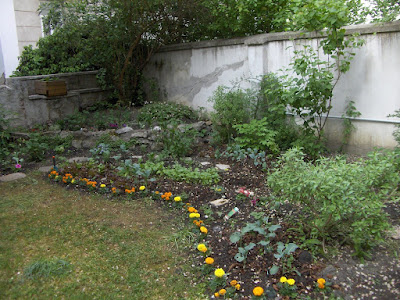
Many vegetables:
- Tomatoes (different varieties), 11 plants
- Eggplant, 1 plant
- Peppers, 3 plants
- Cucumber, 3 plants
- Pumpkin (muskat provence), 2 plants
- Zucchini, 3 plants (now blooming)
- Spinach, several plants
- Lettuce (different varieties), several plants
- Rucula, several plants
- Swiss-chard (two varieties), several plants
- Broccoli, several plants (very beautiful, still untouched by pests)
- Kohlrabi (purple variety), several plants
- Leek, several plants
- Garlic, several plants
- Carrots (including purple haze variety), several plants
- Radish, several plants
- Beets, several plants
- Hamburg Parsley (roots), two plants
- Celery, several plants
- Celeriac, a few still small plants (crop was mainly eaten by slugs)
- Chicory, a few still small plants (crop was mainly eaten by slugs)
- Potatoes and black potatoes, several plants
- Beans (different varieties), several plants
- Peas, a few plants (crop has failed)
- Chick peas, a few plants
- Lentils, a few plants (crop is doing badly, maybe due to cool weather)
- Good King Henry, 1 plant
- Yacon, 1 plant
- Tiger Nuts, several plants (delicious tubers!)
- Chinese artichokes, several plants
- Jerusalem artichokes (tupinamps), 4 plants
- Skirret, 2 plants
- Peanuts, 4 plants (they struggle against the cool climate)
- Sweet potatoes, 1 plant (now sprouting indoors)
- Strawberry spinach, 3 plants
- Blueberry
- Raspberry
- Strawberry (two varieties)
- Elderberry
- Strawberry mint (delicious smell!)
- Savory
- Wormwood
- Thyme
- Lavanda
- Parsley
- Chives
- Catnip
- Lemon verbena (delicious tea!)
- Lemon grass
- Lemon balm
- Bergamot herb (still very small)
- Coriander (still small, slugs have eaten a lot of them)
- Lemon tree
- Bergamot tree
- (To be updated soon)
- Quinoa (sprouts but then fails, since it requires hot weather)
- Millet (we couldn't sprout it yet)
- Rice (sprous but then fails to grow)
- Mung beans (still very small since it requires hot weather)
- Salsify (sadly, it has rotted, or eaten by slugs, last week)
- Wheat, Oats
- Amaranth
- Cumin
- Flaxseed
- Soy beans (maybe they will fail to grow, due to the cool climate)
In our small city garden, that had only 3-4 hours of direct sunlight.
We experiment with a lot of biodynamic planting, and companion planting.
This week, we will apply a nettle liquid-composted fertilizer that is an extremely rich one!






































